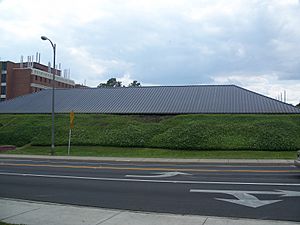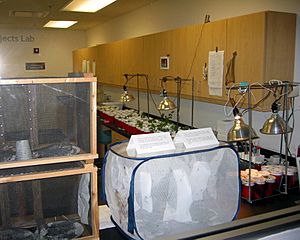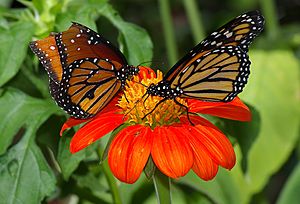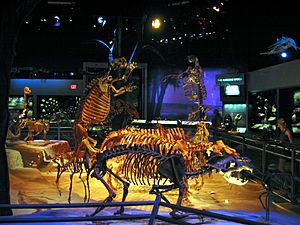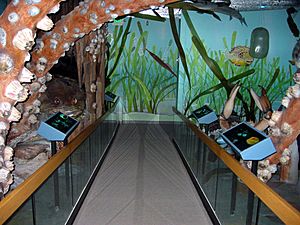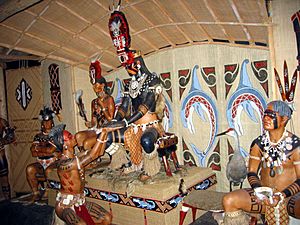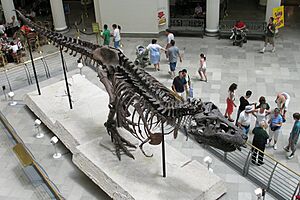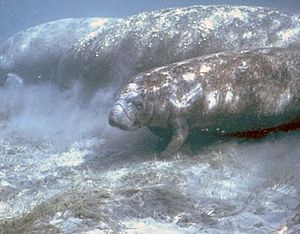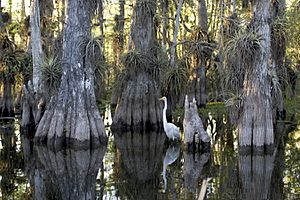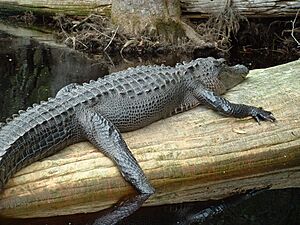Florida Museum of Natural History facts for kids
 |
|
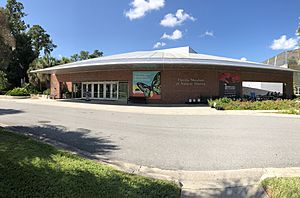 |
|
| Lua error in Module:Location_map at line 420: attempt to index field 'wikibase' (a nil value). | |
| Established | 1891 |
|---|---|
| Location | 3215 Hull Rd., Gainesville, Florida |
| Type | Natural history |
| Visitors | 200,000 est. 2007 |
| Public transit access | Family Housing Stop Route 20 & 21, RTS |
The Florida Museum of Natural History (FLMNH) is Florida's official state museum for natural history. It's located at the University of Florida in Gainesville.
The main public area, called Powell Hall, is in the Cultural Plaza. It shares space with the Samuel P. Harn Museum of Art and the Curtis M. Phillips Center for the Performing Arts. Another important building, Dickinson Hall, is used for research. On April 18, 2012, Dickinson Hall was recognized for its architecture by the American Institute of Architects.
Powell Hall's exhibits show Florida's plants, animals, fossils, and ancient people. Most exhibits are free to enter. However, there is a charge for the Butterfly Rainforest and some special traveling exhibits.
The museum's collections were first used for teaching in the 1800s. They moved to the University of Florida campus in 1906. In 1917, the Florida Legislature officially made it the state's natural history museum. Its name was changed in 1988 to the Florida Museum of Natural History. This helped show its purpose better and avoid confusion with Florida State University.
Contents
- What Does the Museum Research?
- History of the Museum
- Museum Buildings and Locations
- Public Exhibits to Explore
- Research Collections
- Lepidoptera Collection
- Special Collections Building
- Mammal Collection
- Fish Collection
- Shell Collection (Malacology)
- Plant Collection (Botany and Herbarium)
- Reptile and Amphibian Collection (Herpetology)
- Bird Collection (Ornithology)
- Fossil Vertebrate Collection
- Archaeology Collections
- See also
What Does the Museum Research?
The Florida Museum of Natural History received $8 million for research in 2024.
History of the Museum
The Florida Museum of Natural History is the official natural history museum for Florida. Its main goal is to "make scientific investigations toward the sustained development of natural resources and a greater appreciation of human cultural heritage." This means they study nature and human history to help us understand and protect them.
Museum Buildings and Locations
Over more than 100 years, the Florida Museum of Natural History has been in several buildings. These include the Seagle Building in downtown Gainesville and three halls on the university campus.
Dickinson Hall: A Hub for Collections
Dickinson Hall opened in 1971. It holds over 25 million objects and artifacts. These collections include fish, fossils, plants, reptiles, shells, mammals, birds, and items from ancient human sites. It also has a modern lab for studying DNA and evolution.
Powell Hall: Where You See the Exhibits
Powell Hall was built in 1995 in the University of Florida Cultural Plaza. This building, along with the McGuire Center, is where the main exhibits and public programs are held. The funding for Powell Hall came from generous donations and state government money.
Randell Research Center: Studying Ancient People
In 1996, the Randell family donated 53 acres (about 21 hectares) of an important ancient site in Lee County to the University of Florida. The museum now runs this area as the Randell Research Center. It's a place for research and education about the history of people in Southwest Florida.
In 2008, the Randell Research Center planted over 800 native trees. These trees replaced ones that were destroyed by hurricanes in 2004.
McGuire Center for Butterflies and Biodiversity
In 2000, William W. McGuire gave a large gift to create the William W. and Nadine M. McGuire Center for Lepidoptera and Biodiversity. This center focuses on studying butterflies and moths. It opened in August 2004.
The center has over 10 million butterfly and moth specimens. This makes it one of the largest collections of its kind in the world. It even includes specimens of extinct species. The collection combines items from other museums and university collections.
The McGuire Center is used for both research and public education. It includes the living Butterfly Rainforest and exhibit areas. These areas teach visitors about butterflies, moths, and rainforests around the world. The center also has 39,000 square feet (about 3,600 square meters) of research labs and collection space.
Some research labs and collections can be seen through glass panels at the back of the museum.
Public Exhibits to Explore
As of August 2025, the museum’s public exhibits are closed for construction until July 2026. Renovations will include a new exhibit called ‘Earth to Florida.’
Butterfly Rainforest: A Living Exhibit
The Butterfly Rainforest is a special outdoor enclosed space attached to the museum. It's the main exhibit in the McGuire Center. You can enter it from Powell Hall. At any time, you can see over 50 different kinds of butterflies and moths, totaling about 1,000 individuals.
The butterflies are brought from all over the world as chrysalises. They are released into the exhibit after they become adult butterflies. There are live butterfly releases every weekday at 2 p.m. The rainforest also has over 600 plant species, waterfalls, and a special fog system.
Florida Fossils: Journey Through Time
This exhibit in Powell Hall shows the history of Florida over millions of years. It takes visitors through five different geologic time periods. You start in the Eocene epoch, when Florida was underwater. Then you travel through the Oligocene, Miocene, Pliocene, and Pleistocene epochs.
You'll see Florida's first land animals, grasslands, and the land bridge that formed about 3 million years ago. The exhibit ends with the arrival of the first humans in Florida. Over 90 percent of the 500 fossils in the exhibit are real. Many were found close to Gainesville.
At the entrance, you'll see six fossil shark jaws, some as tall as 9 feet (2.7 meters). The exhibit begins with dioramas showing five extinction events. Displays include an ancient whale, a pig-like mammal, a rhinoceros being attacked by saber-toothed cats, and a 15-foot (4.5 meter) tall sloth. You can also see a 500,000-year-old jaguar chasing a peccary. The exhibit also features amazing artwork, like a 9-foot (2.7 meter) tall steel sculpture of an extinct Terror Bird.
South Florida People & Environments
This exhibit in Powell Hall has ten galleries. They offer different experiences, including 3-D environments and learning centers.
Visitors enter through a re-created scene of a Calusa fishing village from 500 years ago. You'll see a young Calusa boy carrying a shark and a view towards the Gulf of Mexico. Large glass panels show art and environments of Southwest Florida's Native Americans. An orientation area helps introduce the exhibit.
Mangrove Boardwalk Gallery
You can walk on a wooden boardwalk through a full-size re-creation of a Southwest Florida mangrove forest and sea grass estuary. The boardwalk goes through mangrove trees, mudflats, and simulated water. Sounds of insects, birds, and water, along with changing lights, make it feel real. A huge mural extends the view to distant islands and bird nesting areas.
Natural Habitats Center
This gallery shows exhibits about the different environments in South Florida.
Underwater Walk-through
This gallery has a 12-times life-size underwater scene. It lets you explore the tiny organisms that support the estuary. Large sculptures of plants, fish, and invertebrates surround the walkway. Shimmering underwater light makes the scene feel real.
Fishing Heritage Gallery
This gallery tells the story of 6,000 years of fishing. It highlights fishing along Florida's Gulf coast. Displays focus on the fishing of the Calusa people and how these traditions continued into the 20th century. You'll learn about fish, nets, ancient fishing methods, and boats.
The exhibit also shows the amazing engineering of the Calusa, who built large canals. Interactive stations show how nets were made. Artifacts include 1,000-year-old palm-fiber fishing nets and ancient wooden canoe paddles.
Calusa Mound and Village
This gallery features a large window looking out onto an outdoor mound. Sculptures of a Calusa family stand on the mound next to a palm-thatched house. Inside, panels explain mounds and Calusa town plans. An interactive model shows a cutaway view of a mound and explains how archaeologists study the past.
Calusa Leader's House
This gallery shows the Calusa society through a re-created scene. You enter a palm-thatched building and find yourself in a Calusa leader's house during a ceremony. Soft lights and sounds of singing add to the drama. Six human sculptures are based on real people from old Spanish documents. The scene is set in the Calusa capital town of Calos around 1564. Panels explain Calusa politics, social structure, and beliefs. Artifacts include shell, bone, and metal ornaments.
South Florida's Native American Legacy Gallery
This gallery shows some of the rarest objects from the South Florida collections. These include a 1,000-year-old hand-carved wooden panel with a painting of the near-extinct ivory-billed woodpecker. There are also wooden panels with painted alligators, animal and human figurines, and metal ornaments. Panels discuss important sites in South Florida. A multimedia interactive explains how to preserve ancient materials found in wet places.
Today's South Florida Indian People
This gallery is about the Indian people who live in South Florida today: the Seminole and Miccosukee tribes. Panels discuss their history and living traditions. Display cases show interesting objects from the museum's collections, like patchwork clothing, woodwork, basketry, and silverwork.
Water Shapes Florida
Opened in 2024, this new exhibit focuses on Florida’s freshwater and wildlife. It has interactive elements, animal replicas, and a simulation of a boat tour.
Florida Wildflower and Butterfly Garden
This garden is next to the McGuire Center. It was funded by the Florida Wildflower Council. The garden has a display showing the life cycles of four butterflies. It also shows how the plants they use change throughout the year.
Changing Gallery: Special Exhibits
The Changing Gallery is a 5,000 square foot (465 square meter) hall in Powell Hall. It hosts special traveling exhibits. Past exhibits have included the Megalodon Exhibit, Chocolate, and Tyrannosaurus rex Sue from the Field Museum in Chicago.
From October 7, 2023, to April 21, 2024, the Changing Gallery hosted Antarctic Dinosaurs, also from the Field Museum.
Research Collections
Most of the museum's research collections are in Dickinson Hall. The Lepidoptera collection is in the McGuire Center.
Lepidoptera Collection
This collection of butterflies and moths is housed at the McGuire Center. It is a newer collection compared to others, but its research is very extensive.
Special Collections Building
Opened in 2022, this building is across from Powell Hall. It holds collections of fish, reptiles, and invertebrates that are preserved in fluid. It is closed to the public and used by researchers.
Mammal Collection
The mammal collection at Dickinson Hall has grown a lot since 1992. It has more than 30,000 specimens. Since 2002, the museum has added collections of whales, dolphins, and manatees.
The collection mainly has skins and skulls. About 4,500 specimens are preserved in fluid. Most of the collection consists of small mammals like rodents and bats from the southeastern US, the Caribbean, and Latin America. There are also 2,600 specimens from Pakistan.
An important part of the collection is marine mammals, including 310 manatees, dolphins, and over 500 whales. The museum also has the largest collection of the endangered Florida panther in the United States.
This mammal collection is mainly for research. However, it's also used for teaching students, helping law enforcement identify endangered species, and studying what carnivores eat. It also helps with biomedical studies and wildlife dentistry.
Fish Collection
The Florida Museum of Natural History's fish collection is one of the most important in North America. It has over 197,000 cataloged groups of specimens, totaling more than 2.15 million individual fish. These represent over 7,000 species.
The collection also has about 2,500 skeletons and specimens that have been cleared and stained for study. The main strengths of the collection are marine fish from the Atlantic Ocean, reef fish, and freshwater fish from the southeastern United States. It also has many freshwater fish from Central and South America.
The museum's collection of sharks and rays has grown quickly and is very important internationally. The museum also helps manage the International Shark Attack File, a database of documented shark attacks. This is for scientists and researchers, not the public.
Shell Collection (Malacology)
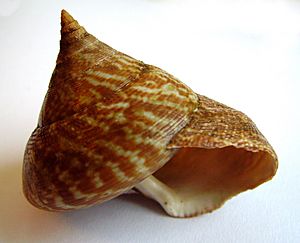
The mollusk (shell) collection started small but has grown rapidly. It now holds over 30,000 species among 400,000 groups of specimens. Over 300,000 of these are available online. It is one of the largest and fastest-growing mollusk collections in the US.
The collection is especially strong in shells from the southeastern US. It has one of the largest collections of land and freshwater mollusks from this region. About 38% of the collection is marine shells, 18% freshwater, and 44% land shells. The museum has the world's largest land snail collection from Hispaniola, Mexico-Central America, Pakistan, and Thailand.
Plant Collection (Botany and Herbarium)
The botany collection has an excellent representation of Florida's plants. It also includes mosses, lichens, and fungi from Florida and tropical areas. The wood collection has samples from all over the world. The total botanical collection has about half a million specimens.
Important additions include collections from famous botanists and donations from individuals. This includes a large collection of plants from the Florida Panhandle.
Reptile and Amphibian Collection (Herpetology)
With about 202,000 specimens, the herpetology (reptile and amphibian) collection is one of the largest in the US. Its skeleton collection is the 5th largest. About 3,800 new specimens are added each year.
The collection has specimens from all over the world. It has large numbers of land tortoises and monitor lizards from Walter Auffenberg's research. Archie Carr and his students contributed many sea turtles. Wayne King's work added the largest collection of Latin American crocodilians. The museum also has recordings of sounds from 46 species of amphibians and 20 species of reptiles.
Bird Collection (Ornithology)
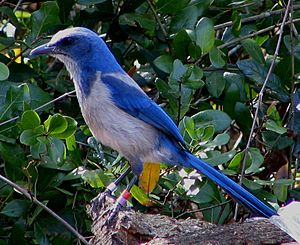
The bird skeleton collection has 24,500 specimens, representing about 3,000 species. It's one of the largest in the world. It has grown by 140% since 2002. Specimens come from 47 U.S. states and 103 countries.
The largest collections by state are Florida (11,169), California (638), and Maine (227). The top ten countries represented are the US (13,282), Mexico (745), and the Netherlands (397).
The bird skin collection has about 20,500 specimens, representing at least 2,300 species. These include rare skins of ivory-billed woodpeckers and extinct dusky seaside sparrows, passenger pigeons, and Carolina parakeets.
The egg collection has 10,400 sets of eggs, representing 733 species. It's one of the largest in North America. It includes eggs from about 90% of North American bird species. Rare eggs include those from passenger pigeons and Carolina parakeets.
The bird sound collection has 20,500 recordings, representing about 3,000 species. It's the fourth largest in the world. The recordings were digitized starting in 2009 and are available online. The collection is strong in sounds from North America and the Neotropics.
Fossil Vertebrate Collection
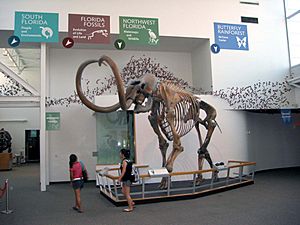
The museum's vertebrate fossil collections have rich samples of all vertebrate classes, mostly from the Cenozoic Era. This includes about 400,000 specimens. These collections are the most complete basis for studying Cenozoic vertebrate paleontology in the southeastern United States and the Caribbean.
The museum uses 3-D printing technology to help with paleontology research. This technology is also used for museum outreach and to create lesson plans for schools.
History of the Fossil Vertebrate Collections
University of Florida (UF) Collection
The UF collection has about 385,000 specimens. It has grown very quickly since the 1950s and is now one of the top five collections in the country. About 90% of this collection comes from Florida. It provides the best record of ancient vertebrate life in eastern North America over the last 25 million years. Other strengths include fossils from Haiti, the Dominican Republic, and other Caribbean islands.
Before 1953, the UF collection was small. Serious fossil hunting began in 1953. In 1964, the museum hired two vertebrate paleontology curators, S. David Webb and Thomas H. Patton. They quickly made the museum's research program a leader in the field. They also helped create the Florida Paleontological Society, connecting professional paleontologists with amateur fossil collectors.
Florida Geological Survey Collection
The Florida Geological Survey (FGS) fossil vertebrate collection started in the 1910s. It was the main source for describing Florida's fossil vertebrates until the early 1960s. In 1976, the entire FGS fossil vertebrate collection was moved to the Florida Museum of Natural History. This collection has about 22,000 specimens, mostly from Florida. Its main strengths are important samples from the early Miocene Thomas Farm locality and the late Pleistocene Vero locality.
Pierce Brodkorb Collection
The Pierce Brodkorb Collection was built by Professor Brodkorb, an expert on fossil birds. His family donated his collections of modern bird skeletons and fossil birds to the museum in 1992. The fossil bird collection has about 8,500 specimens. About 85% of these were collected in Florida.
Archaeology Collections
Environmental Archaeology
The Environmental Archaeology Program (EAP) was started in the early 1960s. It includes archaeological animal, plant, and soil materials. These represent 14,000 years of human-environment relationships in the Americas. The collections are strongest in animal specimens, but also include plant and soil materials. Environmental archaeology studies the long relationship between people and their environments. EAP researchers explore how people used and impacted natural resources.
Caribbean Archaeology
The Caribbean Archaeology Program Collection was founded in 1960. It has one of the largest collections of pre-Columbian artifacts in North America. The collection includes items from sites on many Caribbean islands. These collections have detailed documentation.
The "Bullen" collection was recently reorganized. Type collections, which are artifacts shown in publications, were also created. These catalogs are available for all islands and sites in the collection.
The collection also includes artifacts from excavations in Antigua and St. Kitts. Since 1987, museum research teams have done surveys and excavations in Antigua, the Bahamas, Grand Cayman, Grenada, Haiti, Jamaica, and the Turks and Caicos Islands.
Ceramic Technology Laboratory
The Ceramic Technology Laboratory was started in 1977. It studies pottery from archaeological sites. Pottery analysis is important because pottery is often the most common material found at these sites. The lab has equipment to study the clay and minerals in pottery. This helps researchers understand when and where pottery was made, how it changed over time, and how societies developed.
The lab has a large collection of prehistoric and historic Native American pottery from Florida and the Southeastern U.S. These collections are used by museum scientists and visiting researchers.
Florida Archaeology
The Florida Archaeology Collection includes artifacts from 12,000 years of human history in the Southeast. While it focuses on Florida, it also has some materials from Georgia. These items are kept as a record of the people who lived in Florida. The collections come from Central and North Florida.
The Excavated Collections include all archaeological materials found using careful digging methods. These collections have information about where they were found, along with field notes, maps, and photos.
Here are some important sites in the Florida Archaeology Collections:
Abraham's Old Town
Abraham's Old Town is a site in Sumter County. It was inhabited by Black Seminoles in the early 1800s. The collection includes stone tools, pottery, glass beads, and metal fragments found during excavations from 1998 to 2001.
Aucilla River Prehistory Project
This collection has prehistoric stone, bone, and mammoth ivory tools. It also includes pottery, historic materials, and fossils from sites along the Aucilla River. Notable items are fossilized bones of ancient animals with cut marks, stone tools, and carved ivory shafts.
Bolen Bluff
Bolen Bluff is a site south of Paynes Prairie. It was excavated in 1949. The collections include many stone points and tools, as well as different types of pottery.
de Soto Survey
The de Soto archaeological survey project (1986–1991) looked for early Spanish-Indian contact sites in North Florida. It identified over 750 sites. Major sites found and excavated include the Spanish mission at Fig Springs and the Indian Pond site.
McKeithen Site
The McKeithen Site is a Weeden Island (AD 200–900) site in Columbia County. It was excavated in the late 1970s. The collections include excellent Weeden Island pottery, stone tools, and animal and plant remains.
Richardson Site
The Richardson Site is a Potano Indian village near Orange Lake. It dates from the late pre-Columbian and early Spanish mission period. It provides information on Potano houses and early Spanish missions. Collections include pottery, stone tools, glass beads, and animal remains.
Spanish Mission collections
Collections from Spanish mission sites are an important part of Florida archaeology. The museum has large collections from 11 mission sites. There are also other Spanish mission period sites.
Tatham Mound
Tatham Mound is a Safety Harbor culture mound in Citrus County. It was also used when the Soto expedition arrived in the mid-1500s. The collections include Safety Harbor pottery, stone tools, and many shell artifacts. Spanish artifacts include metal beads, glass beads, and armor fragments.
Donated private collections
Private collections donated by individuals are an important part of the Florida Archaeology collections. These collections have artifacts from all over Florida. They are valuable for exhibits and research.
Bullen Projectile Point Typology Collection
This collection is the original set of artifacts that archaeologist Ripley P. Bullen used to create the first formal way to classify stone points in Florida in 1967. This collection is used as a reference for researchers and the public.
Human Skeleton Collections
Human skeleton collections at the Florida Museum of Natural History include remains from ancient and historic archaeological sites across Florida, Georgia, and the Caribbean. These collections are used for research and teaching. Access to these collections is limited to academic researchers.
Historical Archaeology
The historical archaeology collections have more than 2 million excavated items from over 100 sites in Florida and Latin America. They include the largest collection of Spanish colonial archaeological items in the country. These items are from homes, military sites, churches, and businesses dating from 1492 through the 1800s.
The collection also has items from non-Spanish sites from the 1700s and 1800s. These include farms, plantations, trading posts, forts, and towns.
The St. Augustine Collections
The materials from St. Augustine, Florida (1565–present) come from archaeological digs over 40 years (1959–1999). They include over 1 million items of glass, metals, stone, shell, and bone. They are managed by the University of Florida and the City of St. Augustine.
The Latin American Collections
Some of the earliest historical archaeology collections in the region are here. John Goggin's work in the 1940s and 1950s created a large collection of materials from sites throughout the Caribbean and Central America.
Excavations in Haiti also created two large historical collections. These are managed by the Florida Museum of Natural History for the Haitian government.
The Historical Florida Collections
In addition to St. Augustine and Latin America, the Historical Archaeology collections also include materials from various towns, missions, plantations, and forts in Florida and the southeastern United States.
See also
 In Spanish: Museo de Historia Natural de Florida para niños
In Spanish: Museo de Historia Natural de Florida para niños


